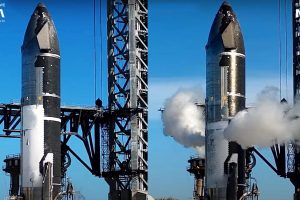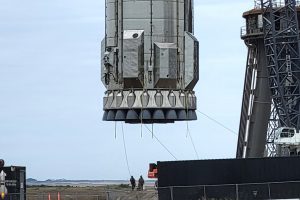CEO Elon Musk has provided a small update on SpaceX’s next-generation Starship rocket in a brief statement to and Q&A with the board of the US National Academies of Science, Engineering, and Medicine.
While it’s now been more than two years since Musk last gave a proper presentation on the Starship program, a number of excellent questions from board members still managed to extract a handful of new details about the fully reusable rocket, which the SpaceX CEO says aims to “be a generalized transport mechanism for the [entire] solar system.” According to Musk, though, the most pressing near-term issues facing SpaceX are more down to Earth.
Reiterated several times in his comments to the National Academies, Musk says that the current limiting factor for Starship is securing regulatory approvals from the FAA for the rocket’s first orbital test flights, which SpaceX and Musk initially hoped would begin as early as mid-2021. Targets from July to November 2021 have since come and gone, while SpaceX has only begun to make concerted progress towards Starship’s first orbital launch in the last two or so months. Almost two months after its first rollout, Starship S20 – the first orbital-class prototype – began integrated testing, completing ambient and cryogenic proof tests in late September and its first Raptor preburner and static fire tests in the second half of October.
Most recently, after almost a month spent inactive at SpaceX’s Starbase test facilities, Starship S20 fired up all six of its Raptor engines – the first test of its kind and a major milestone for the program. Save for the completion of some relatively simple closeout tasks, Starship S20 is now more or less qualified for flight after its successful static fire. That leaves Super Heavy Booster 4 (B4) – the first stage meant to carry Ship 20 into space – up next on SpaceX’s South Texas testing docket after almost four agonizing months spent sitting, untested, at various Starbase facilities.
Musk says that SpaceX preparing to complete “a bunch of tests in December” with the implication that those tests likely include the first full Super Heavy wet dress rehearsal (WDR) with thousands of tons of live propellant and the first several booster static fire tests. Recently refitted with 29 Raptor engines for the third time in four months, it appears that SpaceX is finally close to finishing Super Heavy B4 to a point that will allow the booster to begin integrated testing. Through Super Heavy B3, which completed testing this summer, SpaceX thankfully already knows that the basic booster design is a structurally sound pressure vessel with plumbing and systems capable of surviving a three-Raptor static fire.

Still, that’s barely more than 10% of the total number of engines Super Heavy will need operational to send Starship to orbit. After months at the pad, SpaceX is finally closing out Booster 4’s aft section and installing a basic heat shield around its 29 Raptor engines, which will produce up to ~5400 metric tons (~12M lbf) of thrust at liftoff – more than any other rocket in history. Following Starship S20’s recent success, SpaceX has now fired six Raptors simultaneously and in close proximity without issue. However, Super Heavy B4 will have to fire 29 engines packed into roughly the same amount of space. No other liquid rocket stage in history has a more densely-packed thrust section, averaging at least 85 tons of thrust per square meter (~125 psi) of available engine space.
It’s thus likely that SpaceX will split Super Heavy B4’s first static fire campaign into several different parts, possibly involving seperate tests of the center cluster of nine Raptor Center (RC) engines and outer ring of 20 Raptor Boost (RB) engines before firing up all 29 together. Even if that testing is completed without issue on the first attempts, SpaceX will still likely want to perform a full wet dress rehearsal – and possibly even another 29-engine static fire – with Ship 20 installed on top of Booster 4.

Musk also believes that Starbase’s first orbital launch site will be complete as early as “later this month” – essential for full booster testing. Once all testing is complete, Musk says Starship, Super Heavy, and Starbase should be ready for their first orbital launch attempt as early as January or February 2022. Of course, that launch is entirely contingent upon FAA environmental approval and launch licensing, the former still incomplete and the latter unable to proceed until the former is complete. If the FAA reaches a favorable conclusion, meets its recently-announced target of December 31st to complete Starbase’s environmental review, and grants SpaceX a new launch license just days or a few weeks later, a January-February launch isn’t out of the question.
Looking further into 2022, Musk also revealed that he hopes SpaceX will complete “a dozen [Starship] launches” next year – incredibly ambitious by any measure. There isn’t a rocket in history that’s achieved double-digit launches in the same year as its debut. More importantly, even if the FAA environmental review SpaceX is in the middle of ends with the best possible outcome for Starship, it limits the company to either 3, 5, or 8 (it’s somewhat ambiguous) orbital launch attempts per year. Still, even a ‘mere’ three orbital Starship launch attempts in 2022 would be an incredible acheivement for SpaceX – let alone five, or Musk’s forecast of a dozen.





